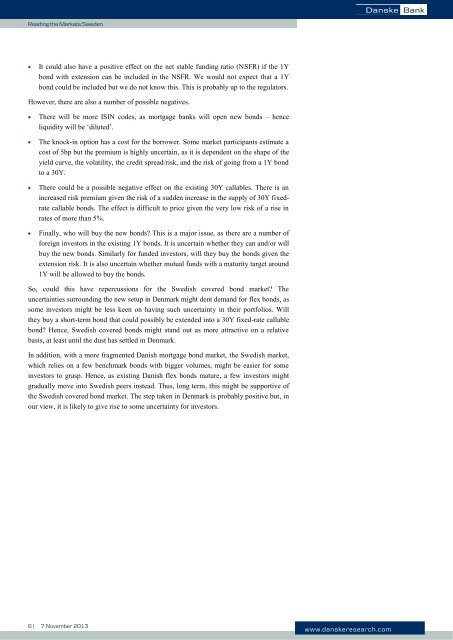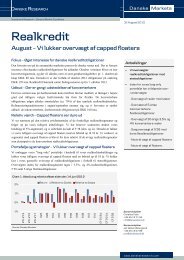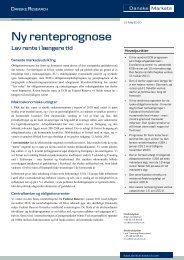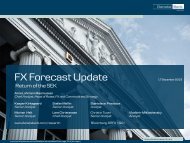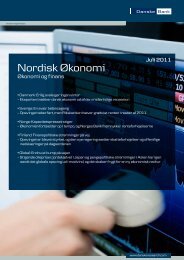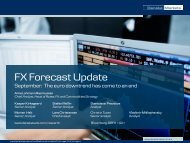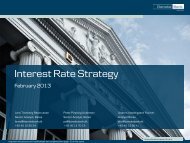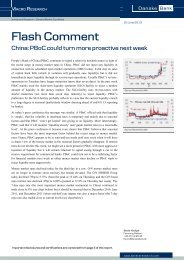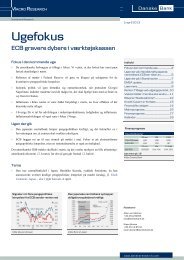Reading the Markets Sweden - Danske Analyse - Danske Bank
Reading the Markets Sweden - Danske Analyse - Danske Bank
Reading the Markets Sweden - Danske Analyse - Danske Bank
You also want an ePaper? Increase the reach of your titles
YUMPU automatically turns print PDFs into web optimized ePapers that Google loves.
<strong>Reading</strong> <strong>the</strong> <strong>Markets</strong> <strong>Sweden</strong>It could also have a positive effect on <strong>the</strong> net stable funding ratio (NSFR) if <strong>the</strong> 1Ybond with extension can be included in <strong>the</strong> NSFR. We would not expect that a 1Ybond could be included but we do not know this. This is probably up to <strong>the</strong> regulators.However, <strong>the</strong>re are also a number of possible negatives.There will be more ISIN codes, as mortgage banks will open new bonds – henceliquidity will be ‘diluted’.The knock-in option has a cost for <strong>the</strong> borrower. Some market participants estimate acost of 5bp but <strong>the</strong> premium is highly uncertain, as it is dependent on <strong>the</strong> shape of <strong>the</strong>yield curve, <strong>the</strong> volatility, <strong>the</strong> credit spread/risk, and <strong>the</strong> risk of going from a 1Y bondto a 30Y.There could be a possible negative effect on <strong>the</strong> existing 30Y callables. There is anincreased risk premium given <strong>the</strong> risk of a sudden increase in <strong>the</strong> supply of 30Y fixedratecallable bonds. The effect is difficult to price given <strong>the</strong> very low risk of a rise inrates of more than 5%.Finally, who will buy <strong>the</strong> new bonds? This is a major issue, as <strong>the</strong>re are a number offoreign investors in <strong>the</strong> existing 1Y bonds. It is uncertain whe<strong>the</strong>r <strong>the</strong>y can and/or willbuy <strong>the</strong> new bonds. Similarly for funded investors, will <strong>the</strong>y buy <strong>the</strong> bonds given <strong>the</strong>extension risk. It is also uncertain whe<strong>the</strong>r mutual funds with a maturity target around1Y will be allowed to buy <strong>the</strong> bonds.So, could this have repercussions for <strong>the</strong> Swedish covered bond market? Theuncertainties surrounding <strong>the</strong> new setup in Denmark might dent demand for flex bonds, assome investors might be less keen on having such uncertainty in <strong>the</strong>ir portfolios. Will<strong>the</strong>y buy a short-term bond that could possibly be extended into a 30Y fixed-rate callablebond? Hence, Swedish covered bonds might stand out as more attractive on a relativebasis, at least until <strong>the</strong> dust has settled in Denmark.In addition, with a more fragmented Danish mortgage bond market, <strong>the</strong> Swedish market,which relies on a few benchmark bonds with bigger volumes, might be easier for someinvestors to grasp. Hence, as existing Danish flex bonds mature, a few investors mightgradually move into Swedish peers instead. Thus, long term, this might be supportive of<strong>the</strong> Swedish covered bond market. The step taken in Denmark is probably positive but, inour view, it is likely to give rise to some uncertainty for investors.6 | 7 November 2013www.danskeresearch.com


